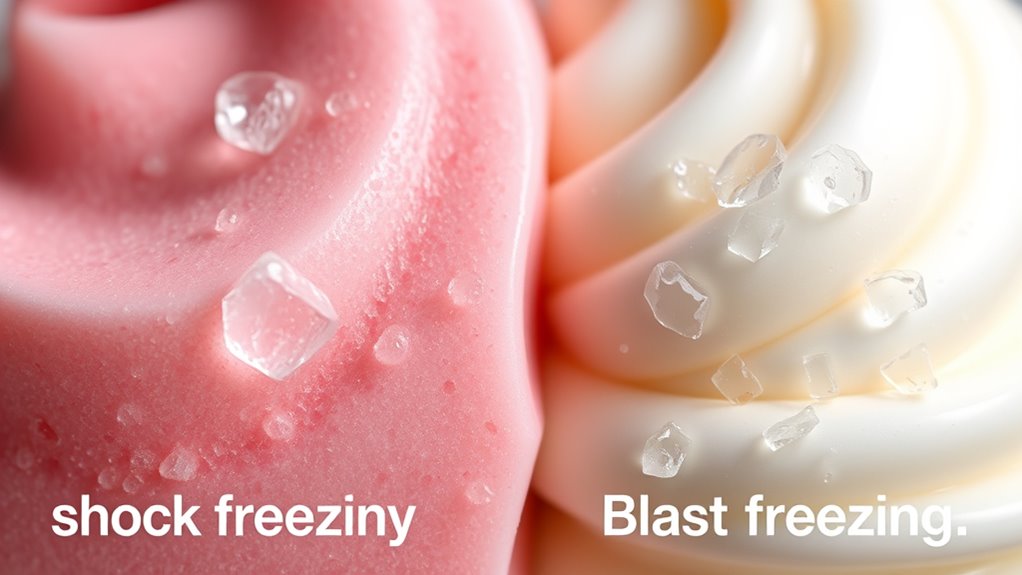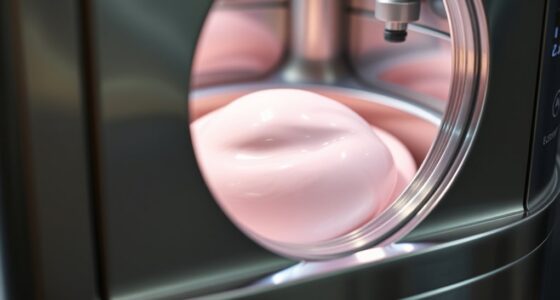If you want silkier gelato, shock freezing is the best choice because it rapidly lowers the temperature and creates tiny ice crystals, resulting in a smoother texture. Blast freezing also improves the texture by freezing faster than traditional methods, but it doesn’t achieve the same level of crystal smallness as shock freezing. Understanding how each method impacts gelato quality can help you choose the right technique for your perfect, velvety treat. Keep exploring to discover which method suits your needs best.
Key Takeaways
- Shock freezing achieves faster temperature reduction, resulting in smaller ice crystals and a silkier gelato texture.
- Both methods prevent large ice crystal formation, but shock freezing is generally more effective for ultimate creaminess.
- Shock freezing typically uses specialized equipment like liquid nitrogen, offering superior rapid cooling.
- Blast freezing is more accessible and practical, providing good but slightly less refined silkiness than shock freezing.
- The choice depends on resource availability, with shock freezing delivering the silkier, more luxurious gelato results.

Freezing is a essential step in making smooth, creamy gelato, and choosing the right method can make all the difference in achieving the perfect texture. When it comes to gelato texture, the freezing speed plays a pivotal role. Faster freezing traps air bubbles and prevents large ice crystal formation, resulting in a silkier, more refined consistency. Two common techniques—shock freezing and blast freezing—offer distinct benefits and can influence your final product differently.
Shock freezing involves rapidly lowering the temperature of the gelato immediately after churning. This method typically uses extremely cold environments, like liquid nitrogen or specialized blast freezers, to bring the gelato from just above freezing to well below freezing in a matter of seconds. The rapid freezing speed minimizes ice crystal growth, which is essential for achieving a smooth gelato texture. When ice crystals are small and evenly dispersed, your gelato feels velvety on the palate, free from icy crunchiness. Shock freezing is especially effective when you want consistent quality, as it preserves the delicate emulsion of fats and sugars, ensuring a luxurious mouthfeel. Additionally, freezing speed is crucial for maintaining the integrity of the gelato’s flavor profile, as rapid freezing helps lock in flavors before they can dissipate.
Shock freezing rapidly lowers gelato temperature, minimizing ice crystal growth for a velvety, luxurious texture.
Blast freezing, on the other hand, employs high-velocity cold air to chill the gelato quickly but isn’t quite as fast as shock freezing. It’s often used in commercial settings where speed is important but not at the extreme level of shock freezing. Blast freezers can rapidly reduce the temperature, but the freezing speed may vary depending on the equipment’s power and the gelato’s initial temperature. This method still markedly improves gelato texture compared to slow freezing, but it might allow slightly larger ice crystals to form if not carefully managed. The key advantage is that blast freezing is more accessible and easier to control, making it suitable for small-scale production or home use if you have the right equipment.
In essence, if your goal is to produce gelato with the silkiest, most refined texture, shock freezing is your best choice. Its superior freezing speed ensures smaller ice crystals and better preservation of the gelato’s smoothness. However, if you’re working with limited equipment or need a practical solution that still enhances gelato quality, blast freezing offers a good compromise. Both methods underscore how essential freezing speed is in shaping gelato texture, and selecting the right technique depends on your specific needs, resources, and desired outcome. Ultimately, mastering these freezing methods helps you craft gelato that’s irresistibly smooth and indulgent.
Frequently Asked Questions
How Does Freezing Speed Affect Gelato Texture?
Freezing speed directly influences gelato texture by affecting ice crystal formation. When you freeze it quickly, the ice crystals stay tiny, leading to a smoother, silkier texture. Slower freezing allows larger crystals to form, making gelato icier and less creamy. For ideal texture enhancement, rapid freezing methods like shock freezing help preserve the gelato’s creaminess by minimizing ice crystal growth, giving you that irresistibly smooth feel.
Can Shock Freezing Preserve Gelato Flavor Better?
Think of shock freezing as the superhero of gelato preservation, much like Clark Kent’s quick change. It preserves flavor better by minimizing ice crystal formation, which helps with taste retention. So, yes, shock freezing can keep your gelato fresher and more flavorful for longer, ensuring each spoonful delivers that vibrant, authentic taste you crave. It’s the best choice for maintaining your gelato’s original flavor profile.
Is Shock Freezing More Energy-Efficient Than Blast Freezing?
When comparing energy consumption and environmental impact, shock freezing tends to be more efficient than blast freezing. It uses less energy because it rapidly cools products with minimal waste, reducing overall power use. This method’s lower energy demands mean a smaller environmental footprint, making it a better choice for eco-conscious operations. So, if you’re aiming for energy efficiency and reduced environmental impact, shock freezing is the smarter option.
Which Method Is Better for Large-Scale Gelato Production?
Imagine you’re steering a ship through rough seas; for large-scale gelato production, the method you choose is your vessel. Blast freezing acts like a sturdy cargo ship, offering quick, consistent ice crystal control and supporting high production scalability. Shock freezing, while gentle, suits smaller batches. For big production needs, blast freezing guarantees efficiency, maintaining quality and smooth texture at a larger scale, making it your best choice.
How Does Freezing Method Impact Gelato Melting Speed?
You’ll notice that the freezing method greatly impacts gelato’s melting speed by influencing air bubble formation and crystal size control. Faster freezing, like shock freezing, minimizes crystal growth and reduces large air bubbles, resulting in a denser, silkier texture that melts slowly. Conversely, slower freezing allows larger crystals to form, increasing melting speed. So, choosing a rapid method helps you create gelato that stays firm longer and melts more gradually on the palate.
Conclusion
When choosing between shock freezing and blast freezing, consider that shock freezing can reduce ice crystal size by up to 50%, resulting in a silkier, smoother gelato. This rapid process preserves the gelato’s texture and flavor better than traditional methods. So, if you want that irresistibly creamy bite, shock freezing might be your best option. It’s a small step that makes a big difference, turning your gelato into a luxurious treat everyone will love.









